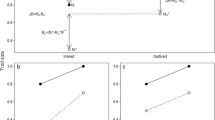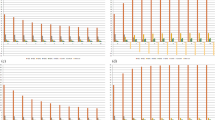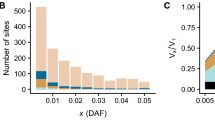Abstract
The mode of within-locus gene action in most genomic regions is termed as the major genomic mode, i.e., it is the within-locus allelic effects in most regions of the genome. Determining whether dominance or overdominance is the major genomic mode is important for two long-standing evolutionary genetics issues: 1. How is the genetic variation in most genomic regions maintained? 2. What is the major mechanism for heterosis? Many efforts have been made, but almost all of them suffer some explanational difficulties. Here we propose an alternative inference approach. It is based on the existent theoretical results on the correlation of the recombination rate and the level of neutral variation in different genomic regions. Positive and negative correlations suggest dominance and overdominance, respectively, as the major genomic mode. Zero correlations imply either few selected sites or about equal composition and distribution of dominant and overdominant regions in the genome, depending on the data distribution. This approach not only avoids all the problems associated with earlier approaches, but it is also particularly useful in organisms where controlled breeding is difficult. Well-corroborated data in Drosophila and recently emerging data in mice and humans all suggest dominance as the major genomic mode.
Similar content being viewed by others
References
Aguade, M. & C. Langley, 1994. Polymorphism and divergence in regions of low recombination in Drosophila, pp. 67-76 in Non-neutral Evolution, edited by B. Golding, Chapman & Hall, New York.
Aquadro, C.F., D.J. Begun & E.C. Kindahl, 1994. Selection, recombination, and DNA polymorphism in Drosophila, pp. 47-70 in Non-neutral Evolution, edited by B. Golding, Chapman & Hall, New York.
Barrett, S.C.H. & D. Charlesworth, 1991. Effects of a change in the level of inbreeding on the genetic load. Nature 352: 522-524.
Begun, D. & C.F. Aquadro, 1992. Levels of naturally occurring DNA polymorphism correlate with recombination rates in D. melanogaster. Nature 356: 519-520.
Cavalli-Sforza, L. L. & W. F. Bodmer, 1971. The Genetics of Human Populations. W.H. Freeman, New York.
Charlesworth, B., M. T. Morgan & D. Charlesworth, 1993. The effect of deleterious mutations on neutral molecular variation. Genetics 134: 1289-1303.
Charlesworth, D. & B. Charlesworth, 1987. Inbreeding depression and its evolutionary consequences. Ann. Rev. Ecolo. Syst. 18: 237-268.
Charlesworth, D., B. Charlesworth & M. T. Morgan, 1995. The pattern of neutral variation under the background selection model. Genetics 141: 1618-1632.
Charlesworth, B. & K. A. Hughes, 1997. The maintenance of genetic variation in life-history traits, in Evolutionary Genetics from Molecules to Morphology, edited by R.S. Singh & C.B. Krimbas. Cambridge University Press, Cambridge, UK, in press.
Crow, J. F., 1952. Dominance and Overdominance, pp. 282-297 in Heterosis, edited by J. W. Gowen. Iowa State College Press, Ames, Iowa.
Crow, J. F., 1993. Mutation, mean fitness, and genetic load, in Oxford Surveys in Evolutionary Biology, Vol. 9., Oxford.
Crow, J. & M. Kimura, 1970. An Introduction to Population Genetics Theory. Happer & Row, New York.
Davenport, C. B., 1908. Degeneration, albinism and inbreeding. Science 28: 454-455.
Deng, H.W., 1998. Estimating (over)dominance coefficient and discriminating dominance vs. overdominance as the genetic cause of heterosis. Genetics 148: in press.
East, E. M., 1908. Inbreeding in corn. Rept. Conn. Agrc. Exp. Stn. (1907) 419-428.
Falconer, D. S., 1989. Introduction to Quantitative Genetics. Longman, New York.
Fu, Y.-B. & K. Ritland 1996. Marker-based inference about epistasis for gene influencing inbreeding depression. Genetics 144: 339- 348.
Fu, Y.-X. & W.-H. Li 1993. Statistical test of neutrality of mutations. Genetics 133: 693-709.
Gregory, W. C., 1965. Mutation frequency, magnitude of change and the probability of improvement in adaptation. Radiation Botany 5 (Suppl.): 429-441.
Hilliker, A. J., G. Harauz, A. G. Reaume, M. Gray, S. H. Clark & A. Chovnick, 1994. Meiotic gene conversion tract length distribution within the rosy locus of Drosophila melanogaster. Genetics 137: 1019-1026.
Houle, D., 1989. Allozyme-associated heterosis in Drosophila melanogaster. Genetics 123: 789-801.
Houle, D., 1994. Adaptive distance and the genetic basis of heterosis. Evolution 48: 1410-1417.
Houle, D., B. Morikawa & M. Lynch, 1996. Comparing mutational variabilities. Genetics 143: 1467-1483.
Hudson, R.R., 1983. Properties of a neutral allele model with intragenic recombination. Theor. Popul. Biol. 23: 1183-201.
Hudson, R.R., 1990. Gene genealogies and coalescent process. pp 1-44 in Oxford Surveys in Evolutionary Biology, edited by D. Futuyma & J. Antonovics. Oxford University Press, Oxford.
Hudson, R.R. & N.L. Kaplan, 1988. The coalescent process in models with selection and recombination. Genetics 120: 831-40.
Hudson, R.R. & N.L. Kaplan, 1994. Gene trees with background selection. pp. 140-153 in Non-Neutral Evolution, edited by B. Golding. Chapman & Hall, New York.
Hudson, R.R. & N.L. Kaplan, 1995. Deleterious background selection with recombination. Genetics 141: 1605-1617.
Hudson, R.R., M. Kreitman & M. Aquade, 1987. A test of neutral molecular evolution based on nucleotide data. Genetics 116: 153- 159.
Kaplan, N.L., T. Darden & R.R. Hudson, 1988. The coalescent process in models with selection. Genetics 120: 819-29.
Kaplan, N.L.. R.R. Hudson & C.H. Langley, 1989. The ‘hitchhiking effect’ revisited. Genetics 123: 887-899.
Kimura, M., 1968. Evolutionary rate at the molecular level. Nature 217: 624-626.
Kimura, M., 1983. The neutral theory of molecular evolution. Cambridge University Press, Cambridge.
King, J.L. & T.H. Jukes, 1969. Non-Darwinian evolution. Science 164: 788-798.
Kreitman, M. & M. Aquade, 1986. Excess polymorphism at the ADH locus in Drosophila melanogaster. Genetics 114: 93-110.
Lande, R. & D.W. Schemske, 1985. The evolution of self-fertilization and inbreeding depression in plants. I. Genetic models. Evolution 39: 24-40.
Lewontin, R.C., 1974. The Genetic Basis of York.
Li, C.C., 1967. Genetic equilibrium under selection. Biometrics 23: 397-484.
Lynch, M. & B. Walsh. 1997. Principles of Evolutionary Quantitative Genetics. in press. Sinauer, Sunderland, MA.
Mandel, S.P.H. 1959. The stability of a multiallelic system. Heredity 13: 289-302.
Maynard Smith, J. & J. Haigh, 1974. The hitchhiking effect of a favorable gene. Genet. Res. 231: 1114-1116.
McDonald, J. & M. Kreitman, 1991. Adaptive protein evolution at Adh locus in Drosophila. Nature 351: 652-654.
Minvielle, F., 1987. Dominance is not necessary for heterosis: a two-locus model. Genetical Research 49: 245-247.
Mitton, J.B., 1993. Theory & data pertinent to the relationship between heterozygosity and fitness, pp. 17-41 in The History of Inbreeding and Outbreeding, edited by N.D. Thornhill. The University of Chicago Press, Chicago.
Nachman, M.W., in review for Genetics. DNA variability, selection, and recombination at four X-linked loci in Mus domesticus.
Nei, M., 1987. Molecular Evolutionary Genetics. Columbia Univ. Press. New York.
Oakeshott, J.G., J.B. Gibson, P.R. Anderson, W.R. Knibb, D.G. Anderson & G.K. Chambers, 1982. Alcohol dehydrogenase and glyceral-3-phosphate dehydrogenase clines in Drosohpila melanogaster on three continents. Evolution 36: 86-96.
Richey, F.D., 1942. Mock-dominance and hybrid vigor. Science 96: 280-281.
Robertson, A., 1962. Selection for heterozygotes in small populations. Genetics 47: 1291-1230.
Schemske, D.W. & R. Lande, 1985. The evolution of self-fertilization and inbreeding depression in plants. II Empirical observations. Evolution 39: 41-52.
Schnell, F.W. & C.C. Cockerham, 1992. Multiplicative vs. arbitrary gene action in heterosis. Genetics 131: 461-469.
Shields, W.M., 1982. Philotary, Inbreeding, and the Evolution of Sex. SUNY press, Albany, New York.
Shull, G.H., 1908. The composition of a field of maize. Rpt. Am, Breed. Assoc. 4: 296-301.
Simmons, M.J. & J.F. Crow, 1977. Mutations affecting fitness in Drosophila populations. Ann. Rev. Genet. 11: 49-78.
Soule, M., 1986. Conservation Biology. Sinauer Association, Sunderland, Mass.
Sprague, G.F., 1983. Heterosis in maize: Theory and practice, pp. 47-70 in Heterosis: Reappraisal of Theory and Practice, edited by R. Frankel, Springer-Verlag, Berlin.
Stearns, S.C., 1992. The Evolution of Life-Histories. Oxford Univ. Press. New York.
Stephan, W., 1994. Effects of genetic recombination and population subdivision on nucleotide sequence variation in Drosophila ananassae, pp. 57-66 in Non-neutral Evolution, edited by B. Golding, Chapman & Hall, New York.
Stephan, W., T.H.E. Wiehe & M.W. Lenz, 1992. The effect of strongly selected substitutions on neutral polymorphism: analytical results based on diffusion theory. Theor. Popul. Biol. 41: 1039-1045.
Stuber, C.W., S.E. Lincoln, D.W. Wolff, T. Helentijaris & E.S. Lander, 1992. Identification of genetic factors in a hybrid from two elite maize inbred lines using molecular markers. Genetics 132: 823-839.
Tajima, F., 1989. Statistical method for testing the neutral mutation hypothesis by DNA polymorphism. Genetics 123: 585-595.
Tajima, F., 1990. Relationship between DNA polymorphism and fixation time. Genetics 125: 447-454.
Tamura, K. & M. Nei, 1993. Estimating the number of nucleotide substitutions in the control region of mitochondrial DNA in human and chimpanzees. Mol. Biol. Evol. 10: 512-526.
Thomson, G., 1977. The effect of a selected locus on a linked neutral locus. Genetics 85: 752-778.
Vigilant L., M. Stoneking, H. Harpending, K. Hawkes, & A. C. Wilson, 1991. African populations and the evolution of human mitochondrial DNA. Science 253: 1503-1507.
Wallace, B., 1989. One selectionist's perspective. Quart. Rev. Biol. 64: 127-145.
Wiehe, T.H.E. & W. Stephan, 1993. Analysis of a genetic hitchhiking model and its application to DNA polymorphism data from Drosophila melanogaster. Mol. Biol. Evol. 10: 824-854.
Wright, S. 1977. Evolution and the Genetics of Populations. Vol. 3. Experimental results and evolutionary deductions. The University of Chicago Press, Chicago.
Zukerkandl, E., 1976. Gene control in eukaryotes and the C-value paradox: ‘Excess’ DNA as an impediment to transcription of coding sequences. J. Mol. Evol. 9: 73-104.
Author information
Authors and Affiliations
Rights and permissions
About this article
Cite this article
Deng, HW., Fu, YX. & Lynch, M. Inferring the major genomic mode of dominance and overdominance. Genetica 102, 559–567 (1998). https://doi.org/10.1023/A:1017084220186
Issue Date:
DOI: https://doi.org/10.1023/A:1017084220186




